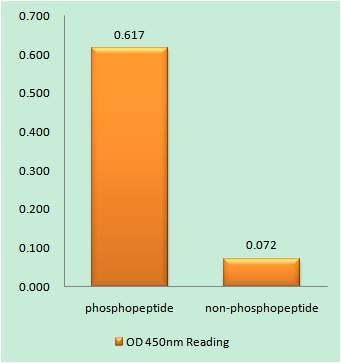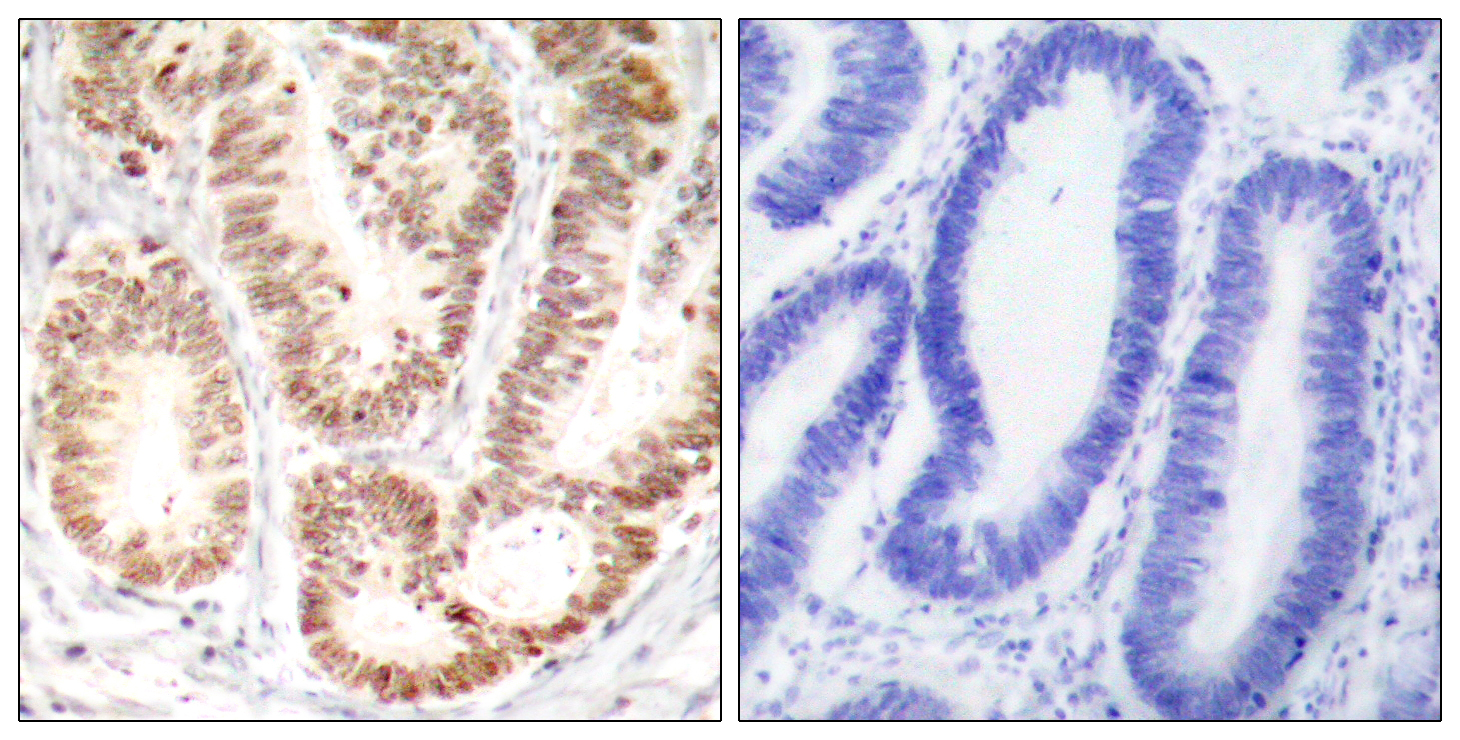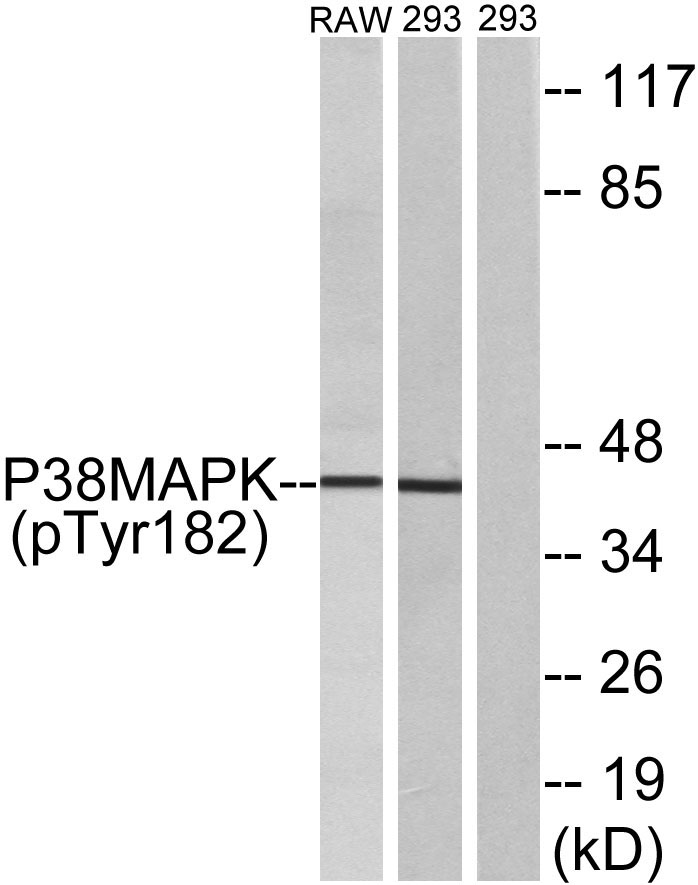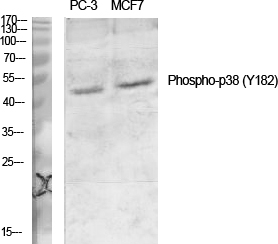产品名称
p38 (phospho Tyr182) Rabbit Polyclonal Antibody
别名
MAPK14; CSBP; CSBP1; CSBP2; CSPB1; MXI2; SAPK2A; Mitogen-activated protein kinase 14; MAP kinase 14; MAPK 14; Cytokine suppressive anti-inflammatory drug-binding protein; CSAID-binding protein; CSBP; MAP kinase MXI2; MAX-interacting protein
蛋白名称
Mitogen-activated protein kinase 14
存储缓冲液
Liquid in PBS containing 50% glycerol, 0.5% BSA and 0.02% New type preservative N.
Human Gene Link
http://www.ncbi.nlm.nih.gov/sites/entrez?db=gene&term=1432
Human Swissprot No.
Q16539
Human Swissprot Link
http://www.uniprot.org/uniprotkb/Q16539/entry
Mouse Gene Link
http://www.ncbi.nlm.nih.gov/sites/entrez?db=gene&term=26416
Mouse Swissprot No.
P47811
Mouse Swissprot Link
http://www.uniprot.org/uniprot/P47811
Rat Swissprot Link
http://www.uniprot.org/uniprot/P70618
免疫原
The antiserum was produced against synthesized peptide derived from human p38 MAPK around the phosphorylation site of Tyr182. AA range:147-196
特异性
Phospho-p38 (Y182) Polyclonal Antibody detects endogenous levels of p38 protein only when phosphorylated at Y182.
稀释度
WB 1:500 - 1:2000. IHC 1:100 - 1:300. ELISA: 1:10000.. IF 1:50-200
宿主
Polyclonal, Rabbit,IgG
背景介绍
The protein encoded by this gene is a member of the MAP kinase family. MAP kinases act as an integration point for multiple biochemical signals, and are involved in a wide variety of cellular processes such as proliferation, differentiation, transcription regulation and development. This kinase is activated by various environmental stresses and proinflammatory cytokines. The activation requires its phosphorylation by MAP kinase kinases (MKKs), or its autophosphorylation triggered by the interaction of MAP3K7IP1/TAB1 protein with this kinase. The substrates of this kinase include transcription regulator ATF2, MEF2C, and MAX, cell cycle regulator CDC25B, and tumor suppressor p53, which suggest the roles of this kinase in stress related transcription and cell cycle regulation, as well as in genotoxic stress response. Four alternatively spliced transcript variants of this gene encoding d
组织表达
Brain, heart, placenta, pancreas and skeletal muscle. Expressed to a lesser extent in lung, liver and kidney.
细胞定位
Cytoplasm . Nucleus .
信号通路
T_Cell_Receptor; Regulates Angiogenesis; Cell Growth; Toll_Like; MAPK_ERK_Growth;MAPK_G_Protein; B_Cell_Antigen
功能
catalytic activity:ATP + a protein = ADP + a phosphoprotein.,cofactor:Magnesium.,domain:The TXY motif contains the threonine and tyrosine residues whose phosphorylation activates the MAP kinases.,enzyme regulation:Activated by threonine and tyrosine phosphorylation by either of two dual specificity kinases, MAP2K3 or MAP2K6, and potentially also MAP2K4. Inhibited by dual specificity phosphatases, such as DUSP1. Specifically inhibited by the binding of pyridinyl-imidazole compounds, which are cytokine-suppressive anti-inflammatory drugs (CSAID). Isoform Mxi2 is 100-fold less sensitive to these agents than the other isoforms and is not inhibited by DUSP1. Isoform Exip is not activated by MAP2K6.,function:Responds to activation by environmental stress, pro-inflammatory cytokines and lipopolysaccharide (LPS) by phosphorylating a number of transcription factors, such as ELK1 and ATF2 and several downstream kinases, such as MAPKAPK2 and MAPKAPK5. Plays a critical role in the production of some cytokines, for example IL-6. May play a role in stabilization of EPO mRNA during hypoxic stress. Isoform Mxi2 activation is stimulated by mitogens and oxidative stress and only poorly phosphorylates ELK1 and ATF2. Isoform Exip may play a role in the early onset of apoptosis.,online information:P38 mitogen-activated protein kinases entry,PTM:Dually phosphorylated on Thr-180 and Tyr-182, which activates the enzyme.,PTM:Phosphorylated upon DNA damage, probably by ATM or ATR.,similarity:Belongs to the protein kinase superfamily. CMGC Ser/Thr protein kinase family. MAP kinase subfamily.,similarity:Contains 1 protein kinase domain.,subunit:Binds to a kinase interaction motif within the protein tyrosine phosphatase, PTPRR. This interaction retains MAPK14 in the cytoplasm and prevents nuclear accumulation. Interacts with SPAG9 (By similarity). Interacts with NP60 and FAM48A.,tissue specificity:Brain, heart, placenta, pancreas and skeletal muscle. Expressed to a lesser extent in lung, liver and kidney.,
纯化
The antibody was affinity-purified from rabbit antiserum by affinity-chromatography using epitope-specific immunogen.




